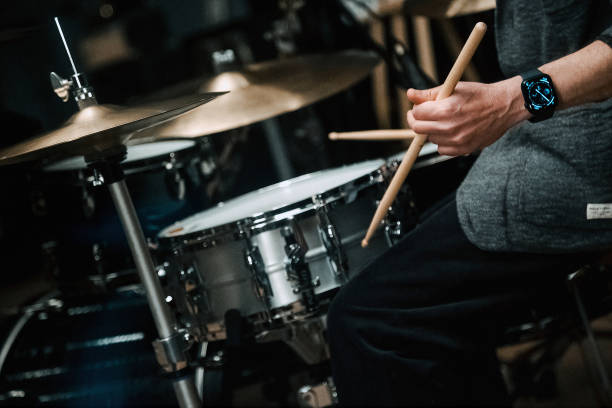Drumming is an exhilarating and dynamic art form, but it also comes with potential risks—particularly to hearing. The loud sounds generated by drums and cymbals can lead to hearing damage over time if proper precautions aren’t taken. Understanding how drumming affects hearing and how to protect yourself can definitely reduce the impact of drumming on hearing as well as ensures longevity in both your musical journey and auditory health.

How Drumming Affects Hearing
1. Exposure to High Decibels
Drums produce sounds that can reach 100-120 decibels (dB), which is well above the safe threshold of 85 dB. Continuous exposure at these levels can cause permanent damage to the delicate structures inside the ears. This is an important impact of drumming on hearing that should be understood.
2. Risk of Tinnitus
Many drummers report experiencing tinnitus—a persistent ringing or buzzing sound in the ears. This can occur after prolonged exposure to loud noises, and in some cases, it becomes a permanent condition.
3. Hearing Loss Over Time
Long-term exposure to loud drumming can lead to Noise-Induced Hearing Loss (NIHL). This results in difficulty hearing high-frequency sounds, affecting a drummer’s ability to distinguish certain tones and nuances in music.
4. Sound Reverberation Issues
Drums are played in various environments, from small practice rooms to massive concert halls. The way sound bounces off walls in enclosed spaces can amplify exposure, further increasing the risk of hearing damage.
Protection Strategies for Drummers
1. Use High-Quality Ear Protection
Investing in earplugs or noise-reducing headphones specifically designed for musicians is one of the best ways to safeguard hearing. This can definitely lessen the impact of drumming on hearing.
- Foam Earplugs: Affordable and widely available, they reduce noise levels but can slightly distort sound.
- Musician’s Earplugs: These reduce volume while maintaining sound clarity, making them ideal for drummers.
- Noise-Canceling Headphones: Effective in lowering ambient noise, these headphones help protect hearing during long rehearsals or gigs.
2. Control Volume During Practice
Playing at lower volumes whenever possible minimizes hearing strain.
- Opt for electronic drum kits, which allow volume adjustments.
- Use practice pads instead of full drum sets when rehearsing technique.
- Play with lighter drumsticks or brushes to reduce overall impact noise.
3. Position Yourself Wisely
The placement of drums and cymbals can significantly impact noise exposure.
- Keep cymbals at a comfortable distance to reduce direct exposure.
- Angle speakers or monitors away from direct ear level.
- Avoid excessive crashing on cymbals, which generate higher decibel levels.
4. Take Regular Breaks
Hearing fatigue happens when ears are exposed to continuous noise. Drummers should:
- Take short breaks every 30-45 minutes during practice.
- Allow ears time to recover in a quiet environment.
- Avoid additional loud noise exposure outside of practice sessions.
5. Incorporate Sound Dampening Solutions
Soundproofing a practice space can help control excessive noise exposure.
- Use acoustic foam panels to absorb sound.
- Install rugs and curtains to minimize reverberation.
- Consider drum shields or isolation booths when playing in confined spaces.
6. Monitor Hearing Health Regularly
Regular hearing check-ups can detect early signs of damage.
- Visit an audiologist annually for a professional hearing assessment.
- Use smartphone decibel meter apps to monitor sound levels during practice.
- Be mindful of any early symptoms, like muffled hearing or temporary ringing.
Adapting Drumming Techniques to Reduce Harm
1. Adjust Playing Style
Hard-hitting drummers experience more hearing strain. Techniques that help include:
- Using glancing strokes instead of full-force hits.
- Practicing stick control to regulate volume.
- Utilizing rim shots and ghost notes for dynamic variety.
2. Use Low-Volume Drum Equipment
Modern drum gear allows drummers to play at reduced volumes without sacrificing quality.
- Low-volume cymbals create less harsh frequencies.
- Mesh drumheads on acoustic kits significantly lower decibel levels.
- Electronic drum kits provide controlled sound output.
3. Be Mindful of Cymbal Use
Cymbals are often the loudest components of a drum set.
- Play them with lighter strokes to decrease sharp frequencies.
- Use sizzle cymbals or mute pads to reduce impact volume.
- Position them at an angle where the direct sound doesn’t hit the ears.
Importance of Hearing Protection for Professional Drummers
1. Long-Term Career Sustainability
Drummers rely heavily on their ability to hear nuances in music. Hearing loss can:
- Make it difficult to distinguish rhythm subtleties.
- Affect communication with bandmates.
- Reduce overall performance quality.
2. Avoiding Performance Fatigue
Strained hearing often leads to mental and physical fatigue. Wearing hearing protection prevents:
- Ear discomfort after long gigs.
- Struggles in mixing and live sound balancing.
- Reduced enjoyment of playing music over time.
3. Enhancing Sound Perception
Contrary to popular belief, using ear protection doesn’t reduce the ability to hear. Instead, it enhances a drummer’s perception of sound clarity.
- Musician’s earplugs preserve sound balance.
- Controlled volume allows better focus on individual elements.
- Protection improves long-term listening skills.
FAQs
1. Can drumming permanently damage hearing?
Yes, prolonged exposure to loud drumming can lead to permanent hearing damage, including noise-induced hearing loss and tinnitus. Using ear protection is essential to prevent long-term harm. This can definitely reduce the impact of drumming on hearing.
2. What are the best ear protection options for drummers?
Musician’s earplugs, noise-canceling headphones, and in-ear monitors are the best options. They reduce harmful noise levels while maintaining sound quality.
3. How loud are drums in comparison to other instruments?
Acoustic drums can reach 100-120 dB, similar to chainsaws or jet engines at close range. This is significantly louder than most other instruments, increasing the risk of hearing damage.
4. Can electronic drums help reduce hearing damage?
Yes, electronic drum kits allow volume control, making them a safer option for long-term hearing protection. They are particularly useful for practice without excessive noise exposure. This can reduce the impact of drumming on hearing.
Drummers face unique challenges when it comes to hearing health, but with the right precautions, they can enjoy long and successful careers without compromising their auditory abilities. Using quality ear protection, adjusting playing techniques, and monitoring hearing regularly are essential steps in safeguarding against hearing loss. By making hearing protection a priority, drummers can continue to create and enjoy music without the fear of long-term damage.
Prioritizing hearing health today ensures a lifetime of musical enjoyment and performance excellence.
